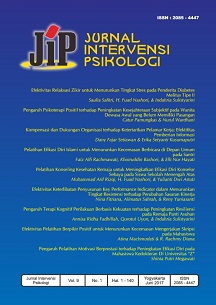Main Article Content
Abstract
This research was purposed to find out the effect of company profile booklet based on compensation and company profile booklet based on organizational support toward applicants attractiveness. Furthermore, this research alsofind out which company profile booklet that has more attractiveness between company profile based on compensation or company profile booklet based on organizational support. The subjects in this research were 60 students in last term who study in Yogyakarta. The data were collected through random sampling technique. Themethod of this research was ‘post test only’ experiment design and using attractiveness scale. Then, this reseacrh was analized using comparison test, Mann Whitney U analysis teqnique. The hypothesis was accepted if this research had significant score p < 0,05 , and the significant score of this research was 0,021, where company profile booklet based on organizational support had higher mean rank score which is 35,70%, meanwhile the mean rank score of company profile based on compensation was 25,30%. It also emphasized that company profile booklet based on organizational support more increase the attractiveness for applicants than company profile booklet based on compensation, and it proves that the hypothesis in this research was accepted.
Key Words: Attractiveness, Compensation, Organizational Support
Article Details
Copyright (c) 2017 Authors

This work is licensed under a Creative Commons Attribution-ShareAlike 4.0 International License.
Authors who publish with this journal agree to the following terms:
- Authors retain copyright and grant the journal right of first publication with the work simultaneously licensed under a Creative Commons Attribution-ShareAlike 4.0 International License that allows others to share the work with an acknowledgment of the work's authorship and initial publication in this journal.
- Authors are able to enter into separate, additional contractual arrangements for the non-exclusive distribution of the journal's published version of the work (e.g., post it to an institutional repository or publish it in a book), with an acknowledgment of its initial publication in this journal.
- Authors are permitted and encouraged to post their work online (e.g., in institutional repositories or on their website) prior to and during the submission process, as it can lead to productive exchanges, as well as earlier and greater citation of published work (See The Effect of Open Access).
References
- Anthony, R.N. & Govindarajan, V. (2007). Sistem pengendalian manajemen. Jakarta: Salemba Empat
- Careernews. (2014). Kutu loncat tak banyak diminati perusahan. Diunduh dari: http://careernews.id/issues/view/2187-Kutu-Loncat-Tak-Banyak-Diminati-Perusahaan/ Tanggal 20 Februari 2016
- Eisenberger, R., & Stinglhamber, F. (2011). Perceived organizational support. Washington DC: American Psychological Asosiation
- Highhouse, S., Lievens, F., & Sinar, E. (2003). Measuring attraction to organizations. Journal of Educational and Psychological Measurement, 63 (6),986-1001
- Kompas.com. (2016). Pilih karyawan setia atau kutu loncat. Diunduh dari: http://www.kompas.com/tips/karir/pilih-karyawan-setia-atau-kutu-loncat-445/ Tanggal 20 Februari 2016
- Lievens, F.., Decaesteker, C., Coetsier, P., & Geirnet, J. (2001). Organizational attractiveness for perspective applicants: a person-organization fit perpective. Journal Applied Psychology 50 (1) 30-51
- Luthans, F. (2006). Organizational behavior 10th Edition.Yogyakarta; ANDI
- Milkovich, G., Newman, J., & Gerhart, B. (2011). Compensation. New York: Mc Graw hill
- Myers, A., & Hansen, C. (2002). Experimental psychology. USA: Wadsworth
- PortalHR.com. (2011). Gaji penyebab utama ketidakpuasan karyawan. Diunduh dari: http://portalhr.com /berita/gaji-penyebab-utama-ketidakpuasan-karyawan/ Tanggal 5 Oktober 2015
- Prabowo. (2014). Dampak buruk tingkat turnover karyawan yang tinggi. Diunduh dari: http://www.bestlife.co.id/lifestyle/the.good.life/dampak.buruk.tingkat.turnover.karyawan.yang.tinggi/004/001/251, tanggal: pada 10 Juni 2015
- Roades, L., Eisenberger, R., & Armenli, S. (2001). Affective commitment to the organization: the contribution of perceived organizational support. Journal of Applied Psychology, 86, 825-836
- Roberson, Q.M., Collins, C.J., & Oreg, S. (2005). The effects of recruitment message specificity on applicant attraction to organizations. Journal of Business and Psychology, 19 (3), 319-339
- Shanock, L.R., Baran, B.E., & Miller, L.R. (2012). Advancing organizational support theory into twenty-first century world of work. Journal Bus psycol (27), 123-147
- Turban, D. (2001). Organizational attractiveness as an employer on college campus: an examination of the applicant Population. Journal of vocational behavior 58, 203-312
References
Anthony, R.N. & Govindarajan, V. (2007). Sistem pengendalian manajemen. Jakarta: Salemba Empat
Careernews. (2014). Kutu loncat tak banyak diminati perusahan. Diunduh dari: http://careernews.id/issues/view/2187-Kutu-Loncat-Tak-Banyak-Diminati-Perusahaan/ Tanggal 20 Februari 2016
Eisenberger, R., & Stinglhamber, F. (2011). Perceived organizational support. Washington DC: American Psychological Asosiation
Highhouse, S., Lievens, F., & Sinar, E. (2003). Measuring attraction to organizations. Journal of Educational and Psychological Measurement, 63 (6),986-1001
Kompas.com. (2016). Pilih karyawan setia atau kutu loncat. Diunduh dari: http://www.kompas.com/tips/karir/pilih-karyawan-setia-atau-kutu-loncat-445/ Tanggal 20 Februari 2016
Lievens, F.., Decaesteker, C., Coetsier, P., & Geirnet, J. (2001). Organizational attractiveness for perspective applicants: a person-organization fit perpective. Journal Applied Psychology 50 (1) 30-51
Luthans, F. (2006). Organizational behavior 10th Edition.Yogyakarta; ANDI
Milkovich, G., Newman, J., & Gerhart, B. (2011). Compensation. New York: Mc Graw hill
Myers, A., & Hansen, C. (2002). Experimental psychology. USA: Wadsworth
PortalHR.com. (2011). Gaji penyebab utama ketidakpuasan karyawan. Diunduh dari: http://portalhr.com /berita/gaji-penyebab-utama-ketidakpuasan-karyawan/ Tanggal 5 Oktober 2015
Prabowo. (2014). Dampak buruk tingkat turnover karyawan yang tinggi. Diunduh dari: http://www.bestlife.co.id/lifestyle/the.good.life/dampak.buruk.tingkat.turnover.karyawan.yang.tinggi/004/001/251, tanggal: pada 10 Juni 2015
Roades, L., Eisenberger, R., & Armenli, S. (2001). Affective commitment to the organization: the contribution of perceived organizational support. Journal of Applied Psychology, 86, 825-836
Roberson, Q.M., Collins, C.J., & Oreg, S. (2005). The effects of recruitment message specificity on applicant attraction to organizations. Journal of Business and Psychology, 19 (3), 319-339
Shanock, L.R., Baran, B.E., & Miller, L.R. (2012). Advancing organizational support theory into twenty-first century world of work. Journal Bus psycol (27), 123-147
Turban, D. (2001). Organizational attractiveness as an employer on college campus: an examination of the applicant Population. Journal of vocational behavior 58, 203-312




